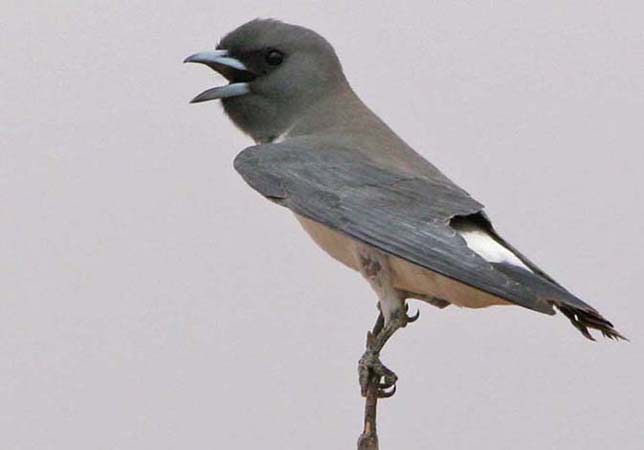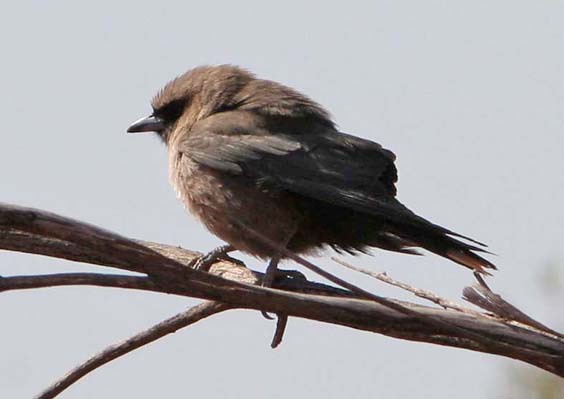| |
|
WOODSWALLOWS Artamidae |
- 11 species from Asia to Australasia
- DR personal total: 7 species (63%), 4 photo'd
|
 The Artamidae is a group of aerial specialists ranging from India to Australia, the most widespread of which is White-breasted Woodswallow (above & left). They glide overhead, like chunky, short-tailed, thick-winged swallows (top photo). The Artamidae is a group of aerial specialists ranging from India to Australia, the most widespread of which is White-breasted Woodswallow (above & left). They glide overhead, like chunky, short-tailed, thick-winged swallows (top photo).
Currently, all woodswallows are placed in the single genus Artamus.
The name is derived from the Greek, and means "butcher" or "murderer."
They were initially considered to be related to shrikes, but genetic
evidence now shows a close relationship to butcherbirds and allies
(more on that below). |
 Most woodswallows are patterned in shades of black, gray, white or brown; one (White-browed Woodswallow A. superciliosus) has rusty underparts. Two of the patterns are shown here (right): White-breasted (upper) and Masked (lower) Woodswallows
perch together. They are both panting in the very hot dry summer along
the Birdsville Track in the desert center of Australia. While most
woodswallows are resident, some undertake seasonal movements, and
others are nomadic, especially in dry country (Rowley & Russell
2009). |
 Woodswallows
build flimsy nests, and many (all?) engage in cooperative breeding
strategies. Black-faced Woodswallow (left) is definitely a cooperative
breeding. In research at nests with banded birds, three helpers
(presumably young from a prior year) help incubate the eggs and chicks;
help in nest sanitation; and help feed the young. Yet, as the nests
were flimsy, they young were often lost in storms that knocked them to
the ground, or from exposure. Even with helpers, the mean success rate
was just 1.5 fledglings per year (Rowley & Russell 2009). Woodswallows
build flimsy nests, and many (all?) engage in cooperative breeding
strategies. Black-faced Woodswallow (left) is definitely a cooperative
breeding. In research at nests with banded birds, three helpers
(presumably young from a prior year) help incubate the eggs and chicks;
help in nest sanitation; and help feed the young. Yet, as the nests
were flimsy, they young were often lost in storms that knocked them to
the ground, or from exposure. Even with helpers, the mean success rate
was just 1.5 fledglings per year (Rowley & Russell 2009).
Away
from the breeding season, woodswallows are generally social birds. They
often forage in flocks, and they often have communal roosts at night. |
Woodswallows
have traditionally been ranked as a family, but their closest relatives
appear to be the butcherbirds, bell-magpies, and allies ( Cracticidae).
There is growing evidence that these two groups form an evolutionary
clade (Sibley & Ahlquist 1990, Barker et al. 2004, Moyle et al.
2006, Jønsson et al. 2010a). The most recent Australian
checklist combines them in a single family (Christidis & Boles
2008), and I had followed that decision for a while. Most world
checklists (e.g., Dickinson 2003, Gill 2009, and the HBW series)
continue to separate them as two families. Given what is known about
their relationships, it is equally appropriate to split them into two
families, or to lump them. Some even lump the boatbills ( Machaerirhynchidae)
in an enlarged Artamidae. Yet woodswallows, butcherbirds, and boatbills
are all quite different sets of birds, so it does seem best to leave
them as three distinctive families. |
| |
Photos: The White-breasted Woodswallow Artamus leucorynchus
in flight was at Port Moresby, Papua New Guinea, in Nov 1983; the
perched bird was along the Birdsville Track, South Australia, on 19 Nov
2009. The photo of White-breasted and Masked Woodswallow A. personatus was also taken 19 Nov 2009 at Lyndhurst, South Australia. The Black-faced Woodswallow A. cinereus was near Erlunda, Northern Territory, Australia, on 18 Aug 2008. Photos © Don Roberson, except that attributed to Steve Wilson and used with permission; all rights reserved.
Bibliographic note:
There is no "family book" per se, but a fine introduction to this
family, with some wonderful photos, is in Rowley & Russell (2009).
Literature cited:
Barker,
F.K., A. Cibois, P. Schikler, J. Feinstein, and J. Cracraft. 2004.
Phylogeny and diversification of the largest avian radiation. Proc.
Nat. Acad. Sci. 101: 11040–11045.
Christidis, L, and W.E. Boles. 2008. Systematics and taxonomy of Australian Birds. CSIRO Publ, Sydney.
Dickinson,
E., ed. 2003. The Howard & Moore Complete Checklist of the Birds of
the World. 3d ed. Princeton Univ. Press, Princeton, N.J.
Jønsson,
K.A., R.C.K. Bowie, J.A.A. Nylander, L. Christidis, J.A. Norman, and J.
Fjeldså. 2010a. Biogeographical history of cuckoo-shrikes (Aves:
Passeriformes): transoceanic colonization of Africa from
Australo-Papua. J. Biogeogr. (forthcoming).
Jønsson, K.A., R.C.K. Bowie, R.G. Moyle, M. Irestedt, L.
Christidis, J.A. Norman, and J. Fjeldså. 2010b. Phylogeny and
biogeography of Oriolidae (Aves: Passeriformes). Ecography 33: 232–241.
Moyle,
R.G., J. Cracraft, M. Lakim, J. Nais, and F.H. Sheldon. 2006.
Reconsideration of the phylogenetic relationships of the enigmatic
Bornean Bristlehead (Pityriasis gymnocephala). Molec. Phylog. Evol. 39: 893-898.
Rowley, C.R., and E.M. Russell. 2009. Family Artamidae (Woodswallows), pp. 286 –307 in
Handbook of the Birds of the World (del Hoyo, J., A. Elliott & D.A.
Christie, eds). Vol. 14. Lynx Edicions, Barcelona, Spain.
Sibley,
C.G., and J.E. Ahlquist. 1990. Phylogeny and Classification of Birds: a
Study of Molecular Evolution. Yale Univ. Press, New Haven, CT.
|
|
|


 The Artamidae is a group of aerial specialists ranging from India to Australia, the most widespread of which is White-breasted Woodswallow (above & left). They glide overhead, like chunky, short-tailed, thick-winged swallows (top photo).
The Artamidae is a group of aerial specialists ranging from India to Australia, the most widespread of which is White-breasted Woodswallow (above & left). They glide overhead, like chunky, short-tailed, thick-winged swallows (top photo).  Woodswallows
build flimsy nests, and many (all?) engage in cooperative breeding
strategies. Black-faced Woodswallow (left) is definitely a cooperative
breeding. In research at nests with banded birds, three helpers
(presumably young from a prior year) help incubate the eggs and chicks;
help in nest sanitation; and help feed the young. Yet, as the nests
were flimsy, they young were often lost in storms that knocked them to
the ground, or from exposure. Even with helpers, the mean success rate
was just 1.5 fledglings per year (Rowley & Russell 2009).
Woodswallows
build flimsy nests, and many (all?) engage in cooperative breeding
strategies. Black-faced Woodswallow (left) is definitely a cooperative
breeding. In research at nests with banded birds, three helpers
(presumably young from a prior year) help incubate the eggs and chicks;
help in nest sanitation; and help feed the young. Yet, as the nests
were flimsy, they young were often lost in storms that knocked them to
the ground, or from exposure. Even with helpers, the mean success rate
was just 1.5 fledglings per year (Rowley & Russell 2009).